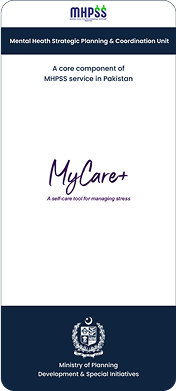Implementation challenges
Implementation of psychological interventions for the frontline workers and vulnerable populations varies across countries, depending on the resources and strength of existing services. Some focus on a single intervention, for example, drop-in psychological sessions for healthcare workers, others offered support within a broader, multitiered, MHPSS programme. The global adoption of digital mental health services accelerated during the COVID-19 outbreak. However, the evidence for scalable digital interventions for mental health in LMICs is limited.
Our challenge was to develop a digital, evidence-based intervention to provide psychosocial support to frontline workers and the vulnerable population when the existing mental health services not only are restricted to bio-medical approaches but are also limited to tertiary care hospitals. The scale of the problem is immense, much beyond the capacity of specialist resources. The intervention to provide psychosocial support needs to be incorporated in a resource limited and fragmented healthcare. Therefore, it has to be contextualized to the local cultural and healthcare context. Finally, this intervention has to be part of a broader MHPSS service so that people, with needs outside the scope of this intervention, can be referred further.
Resource: MyCare+ mobile application
In 2020, and as part of the MHPSS model, a comprehensive, evidence-based intervention was designed to help provide psychosocial support to the frontline healthcare workers manage stress during the pandemic. This intervention was developed into MyCare+ [1] - mobile applications (Android and iOS) - integrated with the MHPSS web-portal. It follows a hybrid approach that offers self-help and option to connect users directly to mental health professionals for one-to-one support when needed.
In 2025, the intervention has been revised to provide psychosocial support to the vulnerable population including those affected by humanitarian and climate related crises, first line responders (e.g. rescue staff, healthcare staff, law enforcement personnel, media persons etc.), women, young people, refugees and marginalized populations experiencing stressful situations in a resource-scarce settings. This application can also be used to support the community volunteer workers at Tier 1 (Hamdard Force).
It is an easy-to-use mobile application with clear instructions (in Urdu and English) for the users to assess and monitor their stress levels, follow personalized treatment goals, and exclude the risk of developing other mental health conditions (Humayun et al., 2020). The assessment protocol for acute stress (within a month of the stressor) is based on the mhGAP-HIG. To help users monitor their adjustment to stressful situation (after a month), the protocol is derived from (ADNM)-8. Figure 4.3 displays home screen of MyCare+ application.
Common sources of stress in the assessment protocol were derived from the reported stressors in Khyber Pakhtunkhwa. The management guidelines have also been adapted from internationally recognized resources. The confidentiality of the user is protected, and consolidated anonymized clinical data is utilized to analyze trends and inform service improvement.

Means of verification
MyCare+ includes distinct sections for assessing and monitoring stress levels, along with a section for screening the risk of other mental health conditions. Each section follows a different set of protocols. These include:
Clinical details: A brief questionnaire has been developed to assess user’s vulnerability to developing mental health conditions.
Sources of stress: A list of commonly reported stressors has been developed [2] to assess environmental challenges.
Stress assessment: The first protocol helps to assess ‘Acute stress’ within a month of a stressful event, adapted from mhGAP-HIG; and the second protocol has been adapted from ADNM-8 [3] to help users monitor their adjustment to stressful situation beyond the first month after exposure to a stressful situation.
Screening risk of other conditions: This section includes screening questionnaires from the mhGAP-HIG for four mental health conditions: depression (12 items), grief (12 items), post-traumatic stress (4 items), and harmful use of substance (5 items). Each question includes supplementary examples (in italics) for a clear understanding of the nature of symptoms
References
Humayun et al., 2020 https://doi.org/10.4103/INTV.INTV_21_20
Humayun et al., 2025 https://doi.org/10.1016/j.ssmmh.2025.100451
Kazlauskas et al., https://doi.org/10.1159/000484415
Mental Health Strategic Planning & Coordination Unit Health Section Ministry of Planning, Development & Special Initiatives